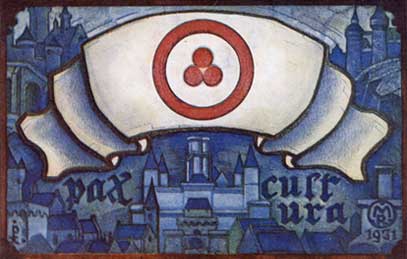Cosmos, bright and multicolored, is gleaming with all the colors of rainbow on the frieze of the hall of the Banner of Peace. Blue luminescence of being born stars and glittering of distant galaxies, mysterious nebulas, and the beauty of dying stars… “Indescribable range of colors! Like on the canvases of painter Nicholas Roerich”, Yuri Gagarin, the first man in space, wrote in the flight log.
In the center of the hall, there is a rotating model of the globe – our Planet, our common home in the space of Cosmos. On the gleaming orbit, there are the models of the orbital space station “Mir” (“Peace”, “World”) and the spacecraft “Space Shuttle”.
And the main, uniting everything exhibit of the hall – the Banner of Peace – “three joined amaranth spheres in a circle at the white background”1 (N. Roerich). Trinity of the most important notions of evolution: the past, present, and future; man, planet, and cosmos; art, science, and religion. The Banner of Culture raised above the Earth by Nicholas Roercih.
 | |
| A postcard by N. Roerich design “Pax Culture”. 1931 |
“Quiet, tortuous devastation of all that was beautiful, noble, cultural is taking place all over Russia, he wrote after traveling around ancient Russian cities. – Bloodless, paralyzing devastation creeps sweeping away all that was sacred, authentic <…> It is sad when ancient times die. But it is even more awful when ancient objects stay disfigured, false, fake”2.
Making speeches in various societies, publishing his essays and articles, he turned to the Russian intellectuals with the appeal “to come to know and love Russia”, to take care of the ancient treasures – the national wealth of Russia – and protect them. He was convinced that “the one who does not know the past cannot think of the future”3. “A lot went wrong in our lives, many foundations got confused, Roerich wrote. – Our art has been filled with the most pervert notions. And the ancient times, if understood the right way, can make kindly soil, not only scientific and artistic, but can become the stronghold of life in its next steps”4.
Nicholas Roerich participated in the work of many congresses and meetings, commissions and committees aimed at protection of art. “Since then, learning persistence from stones, despite all kinds of hostilities, I have kept telling about the beauty of the national wealth”5.
The news of the First World War, carrying death and devastation, aroused anguish in the heart of the artist. “A war with pieces of art, with books, paintings, statues, monuments of architecture… Can the human mind imagine anything more abominable and loathsome!”6 During the years of the war, Roerich turned to all nations with an appeal to protect treasures of art and science. With all his creative work, he asserted the necessity to protect the peoples’ spiritual heritage.
“…We do not think for the sake of “yesterday”, but for the sake of “tomorrow”…, Roerich wrote in 1916. – First of all, do we have right to talk about art? In the days of a great fight, when art seems to keep silent… But genuine art is not stupid luxury. The one who is praying to the god of truth and beauty is not a reckless spender. Art is the need. Art is life… If art serves the Motherland, of course, we should bow to it. And this service is not in official images, but in the uplift of taste, growth of self-awareness, elevation of spirit. In preparation of lofty ways”7.
Already during the Russian-Japanese war, Roerich thought of the necessity of a special treaty for protection of monuments of culture. Immediately after the First World War started, Roerich applied to the Governments of Russia and other countries with a suggestion to enter an International agreement on protection of cultural values in the time of armed conflicts. And though that suggestion never received due support, Roerich did not renounce his idea and came back to it right after the Central Asian Expedition completion.
In 1929, in collaboration with a number of European lawyers, N. Roerich prepared and published in a few languages the draft Pact on protection of artistic and scientific treasures of the world. The agreement text was accompanied with the artist’s appeal to the governments and peoples of all countries to join the Pact, which offered for identification of objects under protection a distinctive sign – the Banner of Peace (a red circle at the white background with three red circles in the middle).
“There were hospitals and doctors long before the Red Cross, Nicholas Roerich wrote, – but an appealing, uniting symbol was needed, and nobody will argue that the Red Cross Banner served for the common benefit. The people needed a Banner, needed an encouraging appeal, especially now, in the epoch of the peoples’ rule. And the Banner of Peace too, it reminds the people of the most essential things – of Peace, of Culture <…> Let the Banner of Culture stream above each cultural center. It will tell the vandals imperatively; “Don’t touch – this is the national wealth here”8.
Roerich called the Banner of Peace the Red Cross of Culture. “If the Red Cross takes care of the physically wounded and sick, our Pact shields the values of the human genius, protecting thus spiritual health”9.
|
|
||
|
||